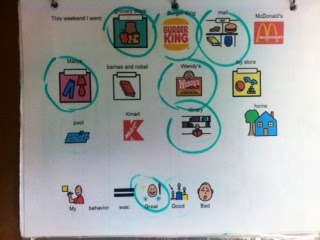Students with autism and other special needs may require lots of visual cues to help support independence throughout the day. Visual supports may supplement verbal instruction, and help to make auditory information visual. Visual supports can also help to encourage communication in the classroom and at home. In order to facilitate communication at home, one of my students fills out a daily communication sheet about what he did that day. I made the communication sheet using Boardmaker, and laminated it so that it can be used daily. He uses a dry erase marker and circles what he did that day. When he gets home, he can tell his mother what he did, using the visual cues as a prompt to help him remember.
The next morning, he fills out another communication sheet so that he can tell his teachers what he did the night before, at home.
Over the weekend he fills out another log to let us know what he did while at home. Monday morning we have a conversation about where he went, what he did, and how his behavior was.
Another one of my students needs to be reminded that she cannot leave the classroom without an adult. We have placed a visual aide on the door (using velcro) and she has to pull the picture cue off of the door, find an instructor, hand it to the instructor and say, "Let's go". We have started to increase the distance between the instructor and the student, and she has to seek out the instructor (from up to 12 ft away) and ask to go outside of the classroom. So far this has been successful, and she uses the visual aide for self-prompting. This has been generalized to the home setting as well, using the same visual prompt. Slowly the picture cue will be faded out, and the goal is for her to always find an adult before leaving the classroom or her home.


I have listed the "Important Times" in the classroom, because no matter how many times we remind one of my students what time lunch is, he still seems to ask each day. After putting up a visual reminder of what time lunch, recess and going home is, he now independently will get up and look at the clocks instead of asking his teachers over and over again.
Visual cues are so important! I know that I cannot function without them (calendars, schedules, to-do lists, cookbooks, maps etc). Students with autism need these visual supports; typically developing students and adults alike benefit from visuals everyday. Have a great Monday!!






No comments:
Post a Comment